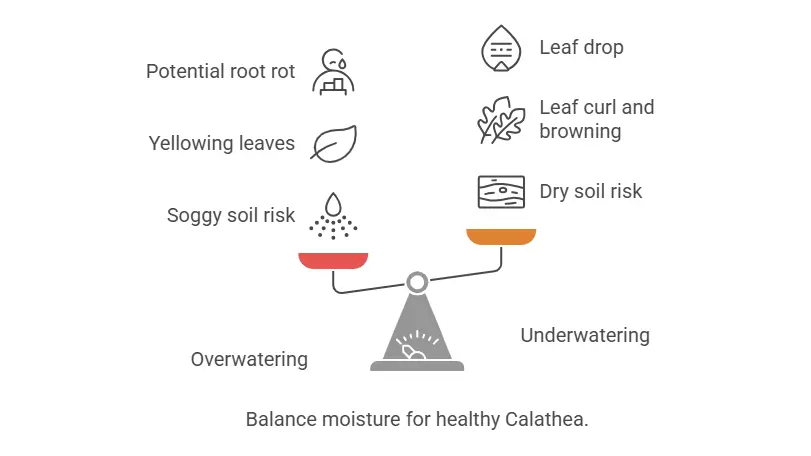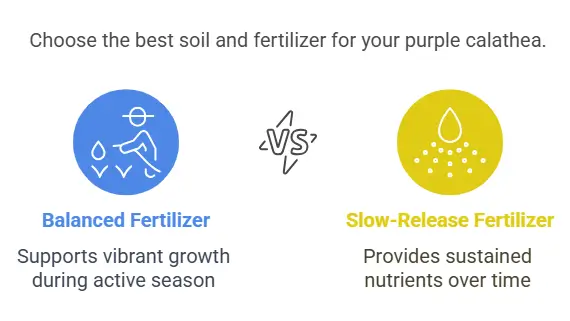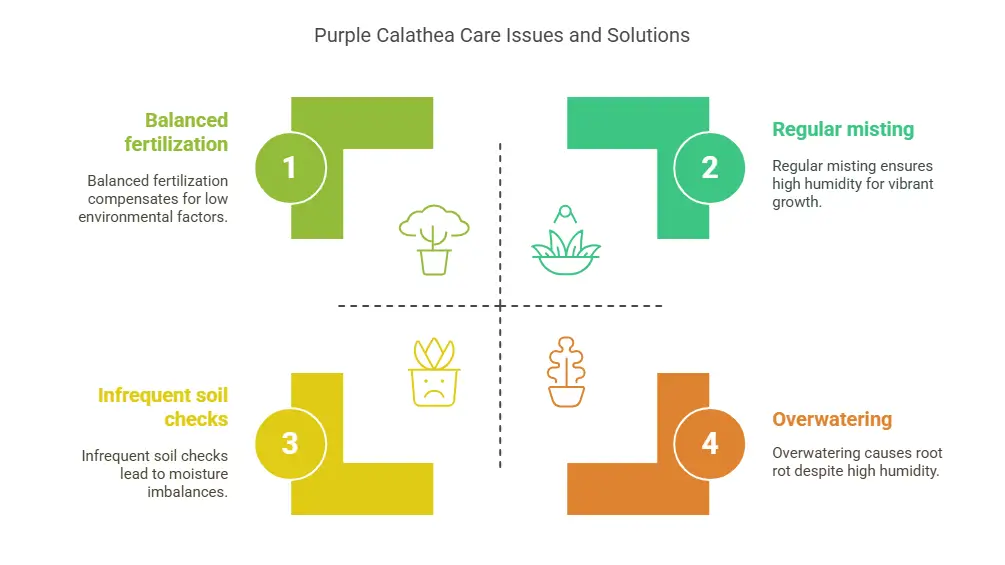It’s always a joy to bring a bit of the tropics indoors, and few plants do it with as much flair as the captivating purple calathea. With their exquisitely patterned leaves that seem almost hand-painted, these beauties can transform any space into a lush retreat.
Table of Contents
The plant we’re focusing on today is the Calathea roseopicta ‘Purple Rose’, a variety that truly lives up to its name. It’s worth noting that the name ‘Rosy’ now often refers to a lighter, almost minty pink variation, making our purple calathea with its bright magenta or hot pink centers and contrasting dark olive to purple maroon edges all the more distinctive.
These aren’t just pretty faces, though. The purple calathea boasts oval leaves with a striking display of color on their upper surface and a deep burgundy underneath, creating a wonderful visual contrast. Even the emerging leaves offer a glimpse of their evolving beauty, starting with pink and green hues before the green deepens. If you’re looking to keep the vibrant purple in your purple calathea shining and ensure your plant thrives, you’ve come to the right place.
This guide will walk you through five essential care tips to help you unlock the full glory of your purple calathea’s foliage and keep it looking its absolute best. We’ll cover everything you need to know for successful purple calathea care, ensuring those stunning colors remain a vibrant feature in your indoor garden.
Here we delve into one of the most crucial aspects of keeping your purple calathea flourishing and showcasing those magnificent colors: light. Just like finding the perfect spot in the garden for a prized bloom, the lighting you provide indoors will significantly impact the vibrancy of your purple calathea’s foliage.
Shining a Light on Purple: Optimal Lighting for Your Calathea

- The Importance of Indirect Light: Think of the natural habitat of these beauties – the understory of tropical forests. There, sunlight is dappled and diffused, not harsh and direct. Your purple calathea thrives under similar conditions. It prefers medium to bright indirect light and can even tolerate low light. However, it’s important to understand that while they tolerate low light, it isn’t ideal for maintaining those rich purple tones. Insufficient light can lead to a gradual fading of the vibrant variegation that makes the purple calathea so special. Imagine the colors dimming, losing their intensity – that’s often a sign your plant isn’t receiving enough light.
- Avoiding Faded Glory: Recognizing Too Much or Too Little Light: Just as crucial as providing enough light is ensuring it’s not too intense. Direct sunlight is a definite no-no for your purple calathea. Those delicate leaves can easily scorch and burn if exposed to strong, direct rays. You might notice crispy brown patches as a telltale sign that your plant is getting too much sun. On the other hand, if your purple calathea is situated in a very dim spot, you might observe the stunning purple hues becoming less pronounced, and the overall leaf color appearing duller. Observing your plant closely will give you valuable clues about whether it’s receiving the right amount of light for those radiant purple shades to truly shine. One observant gardener on YouTube even mentioned keeping their new purple calathea in an eastern window to receive gentle morning light, noting the UV protection in modern windows. This can be a good strategy, but always monitor your plant for any signs of stress. Remember, the goal is to mimic that soft, filtered light of its natural home to keep your purple calathea happy and its foliage vibrantly purple.
Now, let’s turn our attention to the equally vital element of water when caring for your striking purple calathea. Achieving the right balance with watering is key to keeping those beautifully patterned leaves vibrant and the plant thriving.
The Delicate Dance of Watering Your Purple Calathea

Think of watering your purple calathea as a delicate dance – too much, and you risk soggy roots; too little, and those gorgeous leaves will certainly let you know they’re not happy. The goal is to find that sweet spot of consistent moisture without ever allowing the plant to sit in water.
- The “Just Right” Approach: Ideally, the soil for your purple calathea should be kept evenly moist at all times. This doesn’t mean constantly wet, but rather like a well-wrung sponge. A good rule of thumb is to water when the very top inch of the soil feels slightly dry to the touch. It’s better to err on the side of slightly less water than overdoing it. Remember, it’s much easier to add more water than to correct the problems caused by constantly saturated soil.
- Recognizing the Signals: Your purple calathea is quite communicative when it comes to its water needs. Overwatering can lead to a host of issues, including yellowing leaves and potentially root rot. You might also notice the soil staying wet for extended periods. On the flip side, underwatering can manifest as leaf curl, browning tips, and even leaf drop. The vibrant purple undersides might also appear less intense. By paying close attention to your plant’s foliage and the moisture level of the soil, you’ll become adept at understanding its unique rhythm. It’s always a good practice to check the soil moisture regularly.
- Watering Wisdom: When it’s time to water your purple calathea, be sure to water thoroughly so that moisture reaches all the roots. However, always ensure that any excess water can drain away freely from the bottom of the pot. Never let the pot sit in standing water, as this is a surefire way to invite root problems. Furthermore, consider the quality of your water. Many find that using filtered, distilled, or even rainwater is beneficial for calatheas, as they can be sensitive to the chemicals found in tap water. This simple step can contribute to the overall health and vibrancy of your cherished purple calathea. Consistent and thoughtful watering will go a long way in showcasing the rich purple and pink hues that make this plant so captivating.
Continuing our exploration of how to best care for your stunning purple calathea, we now arrive at a factor that is often underestimated but plays a pivotal role in its overall health and the vibrancy of its magnificent foliage: humidity. Coming from the humid understories of tropical forests, the purple calathea truly thrives in moisture-rich environments.
Humidity: The Secret to Thriving Purple Foliage

Think about the air in those lush tropical habitats – it’s thick with moisture, a stark contrast to the often dry air we experience in our homes, especially during heating or cooling seasons. Providing your purple calathea with adequate humidity isn’t just about preventing problems; it’s about creating the conditions where it can truly flourish and display its most radiant purple hues.
- Why Humidity Matters to Your Purple Calathea: The leaves of your purple calathea are more than just beautiful; they actively transpire, releasing moisture into the air. In dry environments, they can lose moisture too quickly, leading to stress. Low humidity is a common culprit behind those tell-tale signs of an unhappy calathea, such as leaf curl, crispy brown edges, and a general lack of vibrancy in the purple coloration. Providing sufficient humidity helps to maintain the integrity of the leaves, allowing them to unfurl fully and display their striking purple undersides and vibrant upper patterns.
- Recognizing the Signs of Low Humidity: Your purple calathea will often communicate its discomfort with dry air quite clearly. Keep an eye out for:
- Edges of the leaves turning brown and crispy.
- Leaves curling inwards.
- A general dullness in the color of the foliage, with the vibrant purple appearing less intense.
- In severe cases, even leaf drop.
- Simple Steps to Boost Humidity for Your Calathea: Fortunately, there are several effective ways to increase the humidity around your cherished purple calathea:
- Misting Regularly: A fine mist of lukewarm water several times a week can provide a temporary boost in humidity. Be sure to mist early in the day to allow the leaves to dry before nightfall, which can help prevent fungal issues.
- Using a Pebble Tray: Place your purple calathea’s pot on a shallow tray filled with pebbles and water. Water vaporizing from the surface raises moisture levels in the plant’s immediate vicinity. Ensure the bottom of the pot isn’t sitting directly in the water to avoid root rot.
- Grouping Plants Together: When grouped, they collectively release water vapor through their leaves (transpiration), boosting local humidity. Placing your purple calathea near other humidity-loving houseplants can create a more humid microclimate.
- Investing in a Humidifier: For consistent humidity, especially during dry seasons, a room humidifier can be a worthwhile investment. Aim for a humidity level between 50% and 70%, which is ideal for most tropical houseplants.
- Terrariums or Cloches: Enclosing your purple calathea in a terrarium or under a cloche can create a consistently humid environment.
By paying attention to the humidity levels around your purple calathea and implementing one or more of these techniques, you’ll be well on your way to maintaining a happy plant with gloriously vibrant purple foliage. Remember, providing the right level of humidity is a key ingredient in the recipe for successful purple calathea care.
Now, let’s discuss the foundation upon which your purple calathea will flourish: the soil it lives in, and the nourishment that keeps it vibrant. Choosing the right soil and understanding its feeding needs are essential steps in ensuring your purple calathea thrives and showcases its stunning colors.
Selecting the Right Soil and Providing Nourishment

Just like selecting the perfect blend of compost for your prized outdoor plants, the soil composition and feeding regimen for your purple calathea indoors will significantly impact its health and the intensity of its beautiful purple variegation.
- Creating the Ideal Foundation: Choosing the Right Soil: For your purple calathea to truly thrive, it needs a soil that provides both adequate moisture retention and excellent drainage. Think of the forest floor where these plants naturally reside – the soil is rich yet allows water to move through freely. A good quality all-purpose potting soil can certainly work as a base. However, for those who wish to provide a more tailored environment for their purple calathea, a mix specifically designed for marantas or formulated with a blend of peat moss or coco coir, all-purpose potting mix, perlite, and a touch of charcoal can be beneficial. This type of mix helps to maintain that crucial evenly moist condition without becoming waterlogged. Remember, allowing your purple calathea to sit in standing water is a recipe for root problems. When it’s time to repot, always choose a well-draining media to support healthy root growth.
- Nourishing Your Purple Beauty: The Right Fertilizer: To keep your purple calathea displaying its vibrant hues, providing the right nutrients during its active growth is important. The growing season for most houseplants, including the purple calathea, typically runs from April through October. During this period, a light feeding every two weeks with a balanced, all-purpose fertilizer diluted to half-strength is generally recommended. Some find success with a slow-release fertilizer applied at planting. Regardless of the type you choose, always follow the fertilizer’s directions carefully to avoid over-fertilizing, which can sometimes leach color from the leaves [20 – from related Coleus care]. During the fall and winter months, when plant growth naturally slows down, it’s best to withhold fertilizer [138 – from related Calathea care in English Gardens]. Observing your purple calathea will provide clues to its nutritional needs. Healthy, vibrant foliage is a good sign you’ve found the right balance. Just as we carefully amend the soil in our outdoor gardens, paying attention to the soil and feeding needs of your indoor purple calathea will reward you with a healthy and beautifully colored plant.
Alright, let’s delve into some of the typical challenges one might encounter while nurturing a beautiful purple calathea, and how to keep its colors as striking as the day you brought it home.
Addressing Common Issues and Maintaining Vibrancy

Even with the most attentive care, your purple calathea might occasionally show signs of distress. Understanding these signals and knowing how to respond is key to maintaining a healthy and vibrant plant.
- Leaf Curl, Browning Tips, and Leaf Drop: As we touched upon earlier, these are often the first indicators that your purple calathea isn’t entirely content. Frequently, low water and low humidity are the primary culprits. Ensure you’re keeping the soil evenly moist and providing adequate humidity through regular misting, a pebble tray, or a humidifier. Remember, these tropical beauties thrive in moisture-rich air.
- Yellowing Leaves: This can stem from a few different issues. Overwatering can lead to yellow, mushy leaves, whereas underwatering might cause foliage to fade and then yellow. Check the soil moisture regularly to ensure you’re striking the right balance. Additionally, inadequate light can sometimes contribute to yellowing. While purple calatheas prefer partial shade to indirect sunlight, too little light can stress the plant.
- Loss of Vibrant Purple Color: The intensity of the purple on your calathea can sometimes diminish. This can be related to several factors:
- Light: While direct sun can burn the leaves, insufficient bright, indirect light might cause the colors to appear less vivid. Position the plant in an area with moderate to strong filtered sunlight for optimal growth.
- Fertilizer: Over-fertilizing can sometimes leach color from leaves. Ensure you are feeding with a balanced, all-purpose fertilizer diluted to half-strength only during the growing season (April through October). Avoid fertilizing in the fall and winter.
- Water Quality: Calatheas may react adversely to chemicals in tap water; Using filtered, distilled, or rainwater is often recommended. The chemicals in tap water can sometimes affect the vibrancy of the foliage.
- Maintaining Overall Health and Preventing Problems: Consistent care is the best defense against common issues.
- Regularly check the soil moisture.
- Monitor humidity levels and take steps to increase them if needed.
- Provide the right amount of indirect light.
- Use a well-draining soil mix. A mix with peat moss or coco coir, all-purpose potting mix, and perlite is often ideal.
- Feed appropriately during the growing season.
- Wipe leaves occasionally to remove dust, which can hinder photosynthesis.
By paying close attention to your purple calathea and addressing any issues promptly with the appropriate adjustments to its care routine, you can ensure it remains a stunning focal point in your indoor garden, showcasing its beautiful purple hues for years to come.
Continuing our journey to master the art of purple calathea care, we now venture beyond the foundational elements and explore some nuances that can truly elevate your success in nurturing these captivating plants.
Beyond the Basics
Once you’ve established a consistent routine for light, water, soil, and humidity for your purple calathea, you might find yourself wanting to delve deeper and provide an even more optimized environment for these tropical treasures.
- The Importance of Water Quality: While we’ve touched on keeping the soil evenly moist, it’s worth emphasizing the quality of the water you use. Calatheas, including the stunning purple varieties, can be sensitive to the chemicals and minerals found in tap water. Over time, these can accumulate in the soil and potentially lead to issues like browning leaf edges. Consider using filtered water, distilled water, or even rainwater for your purple calathea. This simple change can sometimes make a noticeable difference in the overall health and vibrancy of your plant.
- Observing Leaf Movement: One of the fascinating characteristics of calatheas, often referred to as prayer plants, is the movement of their leaves. You might notice the foliage rising and lowering throughout the day and night – this is a natural response to light. Pay attention to these movements; unusually droopy or consistently upright leaves can sometimes indicate that your purple calathea isn’t receiving the ideal amount of light.
- Getting to Know Different Purple Calathea Variations: While we focus on the general care of the purple calathea, it’s interesting to note that there are various cultivars within the Calathea (or Goeppertia) genus that showcase beautiful purple hues. For instance, the Calathea Purple Rose is known for its vibrant pink leaves with dark purple edges, sometimes described with a magenta or hot pink coloration and almost black contrasting margins. The underside of the leaves often complements this with a deep burgundy, making the purple tones truly pop. Another popular choice is the Calathea ‘Dottie’, which also features striking dark foliage. Understanding the specific nuances of your particular purple calathea variety can further refine your care approach.
- Considering Propagation (with Care): While your primary focus might be on nurturing your existing purple calathea, you might eventually consider propagation. The most common method for propagating calatheas is through division during repotting. Gently separating the rhizomes (the underground stems) can create new plants. Proceed with caution and exercise care to prevent harm to the delicate root system. Calatheas can sometimes be a bit more sensitive to division than other houseplants, so ensure each division has a good amount of healthy roots and foliage to increase the chances of success.
- Staying Vigilant for Pests: While generally resilient, your purple calathea can occasionally attract common houseplant pests such as spider mites or mealybugs. Routinely check the leaf undersides and stems for early signs of pests. Early detection is key to easy management. A gentle wipe-down with a damp cloth or a mild solution of soapy water can often take care of minor issues.
By looking beyond the basic care requirements and paying attention to these finer details, you can create an environment where your purple calathea doesn’t just survive, but truly thrives, displaying its magnificent purple foliage in all its glory.
Alright, as we draw to a close on our discussion about the captivating purple calathea, let’s recap the essential elements for keeping these beauties thriving and then address some frequently asked questions.
Conclusion
The allure of the purple calathea with its striking foliage makes it a much-desired addition to any indoor garden. While these tropical plants have specific needs, understanding and meeting them will reward you with a display of vibrant color and unique leaf patterns. Remember the importance of providing the right light – mimicking their native forest floor with medium to bright indirect sunlight is key. Consistent evenly moist soil, achieved by watering when the top inch feels dry and always avoiding waterlogged conditions, is crucial.
Furthermore, the appreciation for high humidity cannot be overstated. Employing methods such as regular misting, pebble trays, or a humidifier will contribute significantly to the health and vibrancy of your purple calathea. During the growing season, a diluted balanced fertilizer every couple of weeks will provide the necessary nutrients, while a rest during the cooler months is beneficial. By paying close attention to these details and being observant of your plant’s signals, you can enjoy the beauty of your purple calathea for years to come.
Frequently Asked Questions (FAQ)
- What kind of light does a purple calathea need? These plants flourish best in indirect light conditions ranging from moderate to bright. Direct sunlight can scorch their delicate leaves. While they can tolerate low light, the vibrancy of their purple coloration may fade. An eastern-facing window with filtered light is often a good choice.
- How often should I water my purple calathea? Aim to maintain consistent soil dampness without waterlogging. Water once the top inch of soil becomes dry. Always ensure the pot has good drainage and never allow your purple calathea to sit in standing water.
- Why are the tips of my purple calathea’s leaves turning brown? Browning leaf tips are often a sign of low humidity or inconsistent watering. Ensure you are providing adequate humidity through misting or other methods and maintaining consistent soil moisture. Using filtered, distilled, or rainwater can also help, as calatheas can be sensitive to tap water.
- My purple calathea’s leaves are curling – what should I do? Leaf curl is another common symptom of low humidity or underwatering. Assess the soil’s moisture level and hydrate only when necessary. Increase the humidity around your purple calathea.
- Should I fertilize my purple calathea? Yes, during the active growing season, which is typically from April through October, you can feed your purple calathea every two weeks with a balanced, all-purpose fertilizer diluted to half-strength. Avoid fertilizing during the fall and winter months.
- What type of soil is best for a purple calathea? A good quality all-purpose potting soil will work. For an even better mix, consider combining peat moss or coco coir, all-purpose potting mix, perlite, and a bit of charcoal to ensure good drainage and moisture retention. A well-draining media is essential.
- Is the Calathea Purple Rose the same as other purple calatheas? While there are various Calathea (now Goeppertia) varieties with purple hues, the Calathea Purple Rose is specifically known for its vibrant pink (sometimes described as magenta or hot pink) leaves with dark purple or almost black edges and a deep burgundy underside. Other purple calatheas like Calathea ‘Dottie’ have their own unique characteristics, often featuring dark foliage.
By keeping these guidelines in mind, you’ll be well-equipped to provide the care your purple calathea needs to thrive and bring a touch of tropical elegance to your home. Happy gardening!

